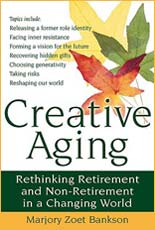Marjory Zoet Bankson, an artist and spiritual guide, is the author of five books, including The Soulwork of Clay: A Hands-On Approach to Spirituality. She is the former president of Faith at Work (now called Lumunos) and editor of Faith@Work Magazine for more than 20 years. She currently offers retreats and workshops and teaches on spiritual companionship at Washington National Cathedral, the Servant Leadership School, and Virginia Theological Seminary in Washington, D.C.
In her soaring introduction to this book, Bankson pays tribute to the social consciousness, advanced education, and good health of Americans retirees. Women are poised to extend their nurturing instincts to others, and men are more sensitive to the needs of others than ever before. She also believes that the spirituality of the Baby Boomers is more personal and less institutional than other generations. All this adds up to a group of elders who want to make the extra years count through new work, part-time employment, and volunteer service. They will be blessed with the gift of whole-heartedness.
Bankson has organized this paperback around the seven phases of transition from a professional career to generativity in the "encore years."
• Release: The Inner Work of Leaving
• Resistance: Moving Beyond Security
• Reclaiming: Riches from the Past
• Revelation: Where Does Newness Come From?
• Crossing Point: Joining Inner and Outer Worlds
• Risk: Beginning Again with More Focus
• Relating: Finding the Right Form for Now
The author is firmly convinced that this transition period can be animated by a serious and sober examination of calling; this involves taking a spiritual look at who we are (our skills and unique gifts) and what we are meant to do in the last stage of our lives. Bankson notes that aging can give us a chance to savor the richness of our creativity and an opportunity to serve in new ways that we never had time for before. She offers vignettes of men and women who have wrestled with a new calling and tried to reclaim unused gifts from the past in their new situations.
Creative aging is a choice we can make looking at the Big Picture, taking risks, believing in our inner voice, and always trying to be of service to others. Post-career generativity is bound to be hindered by the demands of the ego for control, security, and entitlement to the pleasures of self-gratification. Bankson notes: "The rhythm of night and day is a reminder that creative aging is always shadowed by the threat of lassitude, boredom, decrepitude, depression, or drink, which may dog the end of a career and suppress the life-giving energies coursing through us. But the drama of every sunset is also a reminder that, as long as we are alive, the spiral of call never stops." The author makes a good case for creatively making the most out of this stage of life.
